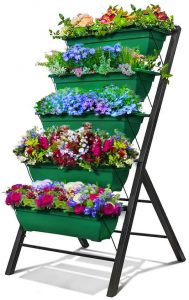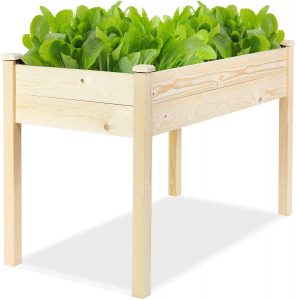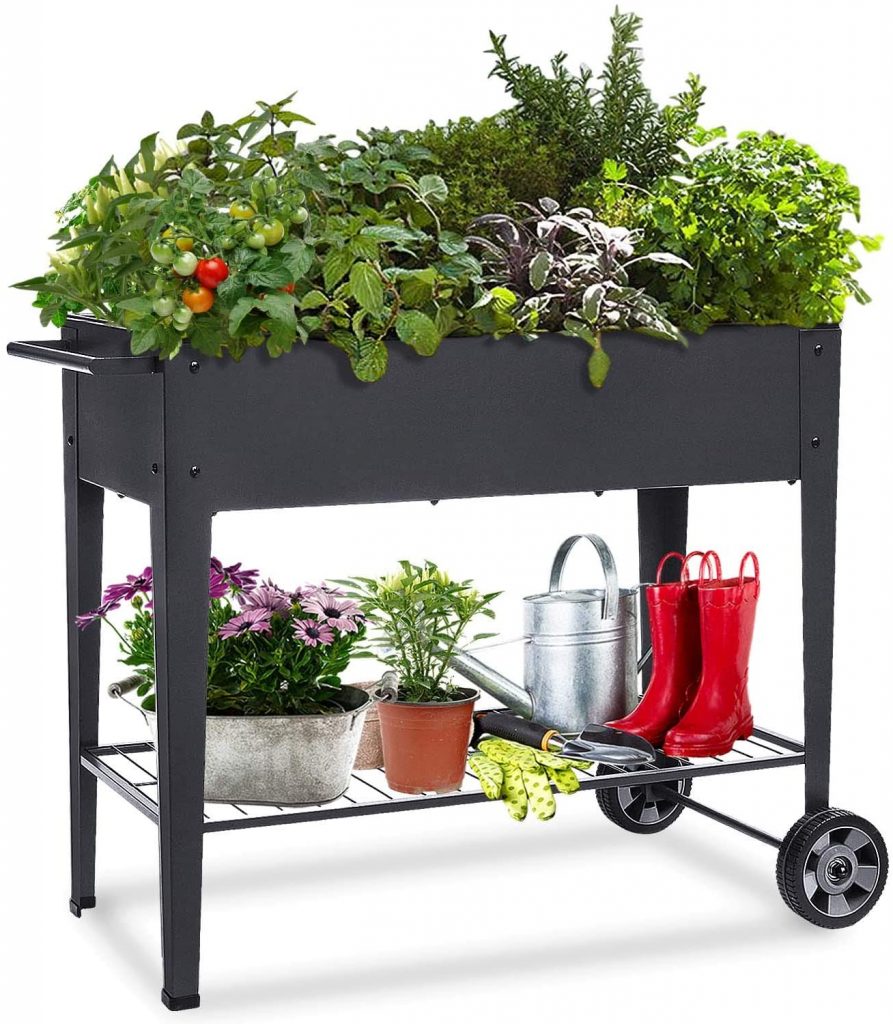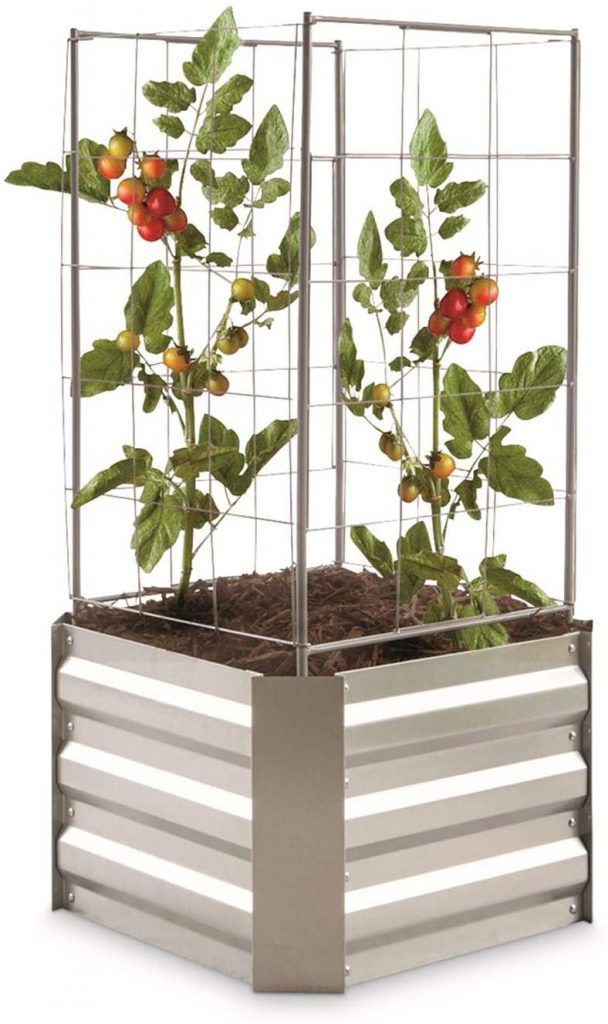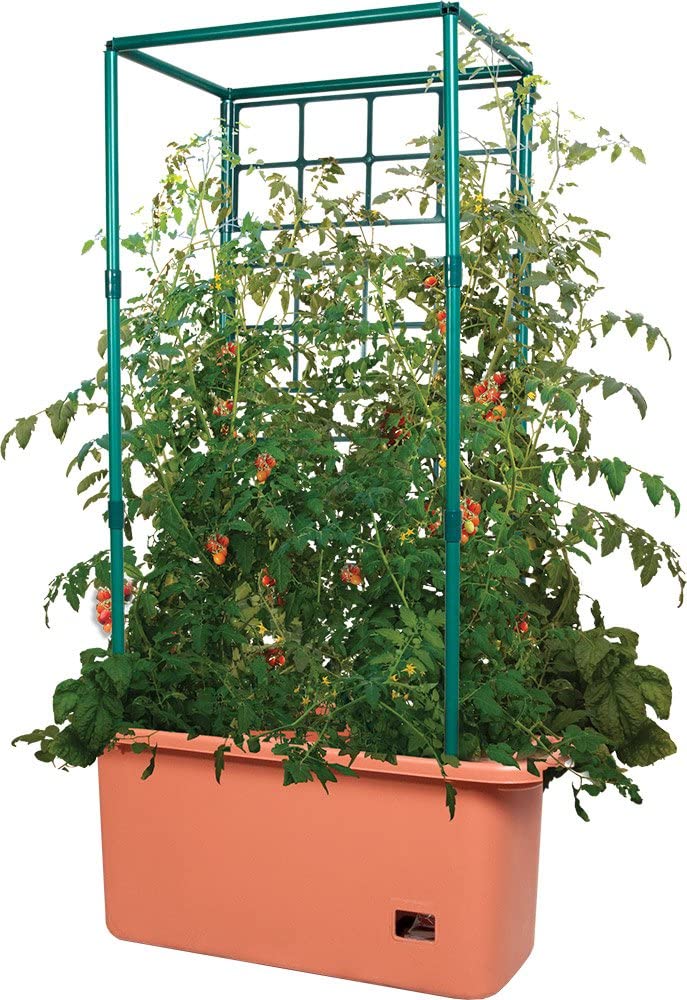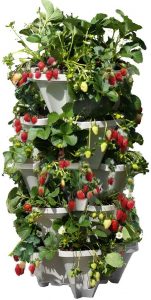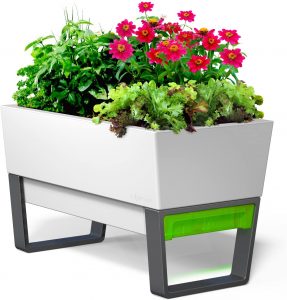Tomato Planter or Planters For Tomatoes. Growing tomato plants in planters or pots or containers is an excellent way to grow homegrown tomatoes all summer long. Especially when you only have small space to grow them.
These planters are created to make you easy to have a bountiful crop of tomatoes. Tomato plants require a lot of suns and need water to thrive well.
This tomato planter (planters for tomatoes) need to be placed in direct sunlight and water well each morning. It would be easy if you follow the instruction and have the right planters and the best tomato planter.
Ways to grow tomato plants
1. In a raised beds
Advantages :
Disadvantages :
2. Using tomato planter
Advantages :
Disadvantages :
7 best tomato planter comparison chart
| Model | Material | Price | Rating | Link |
|---|---|---|---|---|
| Outland Living – 4-Ft Raised Garden Bed – Vertical Garden Freestanding Elevated Tomato Planter | Plastic | $$ | 4.7 | Buy From Amazon |
| Raised Planter Box Legs Elevated Garden Bed For Tomatoes | Steel | $$ | 4.7 | Buy From Amazon |
| Mr. Stacky 5 Tiered Vertical Gardening Tomato Planter | Plastic | $$ | 4.6 | Buy From Amazon |
| Castlecreek Small Square Raised Galvanized Steel Tomato Planter Box with Trellis | Steel | $$ | 4.4 | Buy From Amazon |
| Hydrofarm GCTR Tomato Planter Trellis Garden on Wheels Tree Tower | Plastic | $ | 4.3 | Buy From Amazon |
| Glowpear Urban Garden Self-Watering Tomato Planter | Glass | $$ | 4.3 | Buy From Amazon |
| Giantex Raised Garden Bed Elevated Tomato Planter Fruits Herb | Wood | $$ | 3.6 | Buy From Amazon |
7 best tomato planter reviews
1. Outland Living – 4-Ft Raised Garden Bed – Vertical Garden Freestanding Elevated Planters For Tomatoes Tomato Planter
You can plant tomatoes in the balcony or porch or patio or garden with limited space this Outland Living vertical Tomato Planter. You can assemble by following the instructions included quickly and simple.
It comes with a twenty-four-inch hanging plastic box container that can give enough room for your tomato plants. You can even grow other herbs, flowers, or succulents in just a single area at home.
The tomato planter is made from plastic bins, a 100% Polypropylene material (PP), which is lead-free, mercury-free, and BPA free. The plastic bins have a Cascading Drainage System that allows water flow from the top down to each row to make sure all plants are watered well.
If you have knee and back issues but still want to grow tomato plants, this is the planters for tomatoes products you are looking for. This would be a unique planters for tomatoes for older adults.
The vertical garden bed is built with excellent and high-quality materials to make sure to have the stability of the combined weight of tomato plants, water, and soil. Its frame and planter boxes are weather resistant suitable for outdoor and indoor use.
Pro :
Con :
2. Giantex Raised Garden Bed Elevated Tomato Planter Fruits Herb
This elevated outdoor vegetable planting box can provide an exceptional appearance to your indoor or outdoor decor. You can grow tomato plants in your small patios, your decks, your condos, and apartments.
With the tomato planter, you can also grow herbs, flowers, and other vegetables. You do not have to worry about your tomato plants being exposed to chemicals because it is made from 100% natural Cedarwood without chemical additives added.
It is perfect for people with a back strain and mobility issues because they do not have to bend while planting tomato plants. The robust and thick wood construction makes these planters for tomatoes can serve you for years to come.
It is also easy to assemble without bolts.
Pro :
Con :
3. Raised Planter Box Legs Elevated Garden Bed For Tomatoes
With this tomato planter, you need no worry about the rust. It is made from galvanized steel and coated with an anti-rust black coating, which protects it from corrosion and rust.
The elevated tomato planter from Foyuee provides enough room to grow vegetables, flowers, and herbs. The size is perfect for small outdoor spaces as well as indoor.
The ergonomic design of this planter is for people with a mobility issue. Its handle design and wheels will make the planter for tomatoes easy to move.
Waterlogging issues and root rot can be solved with its drainage line. You will have the planter for years to come with its sturdy, durable, and stylish built.
Pro :
Con :
4. Castlecreek Small Square Raised Galvanized Steel Tomato Planter Box with Trellis
With this raised bed tomato planter, you can control the drainage and the soil content of your tomato plant. This planter is sturdy but lightweight, and it features an open floor to stimulate profound root growth.
You have many choices on what to plant with this tomato planter, including flowers, herbs, and vegetables. You can assemble with multiple boxes a more massive garden bed because it is a modular design.
It is made from galvanized steel with a smooth finish, UV resistant, and easy to assemble.
Pro :
Con :
5. Hydrofarm GCTR Tomato Planter Trellis Garden on Wheels Tree Tower
The Tomato Barrel planting system gives built-in staking for plant support as well as a planting container. This planter for tomato or tomato planter is designed to offer firm support for flowers, climbing plants, peas, beans, and tomatoes.
You do not have to worry about underwatering or overwatering because it comes with an easy-to-fill reservoir that carries nutrients and water from below. When the heavy vines grow, the frame is sturdy enough to support the weight.
This kind of support will also help the growing and climbing plant can focus on giving energy to developing fruit as well as preventing the fruit from falling off.
The dimension of the planter is suitable for your balcony, decks, patio, or porch.
Pro :
Con :
6. Mr. Stacky 5 Tiered Vertical Gardening Tomato Planter
This tomato planter maximizes space and maximizes growth in the area. It is an excellent choice to grow lettuce, herbs, succulents, flowers, and other plants in mind.
When you water your plants, water will go from the top to bottom. The flow-through water design will prevent overwatering that may cause root rot.
It is recommended to use breathable soil or a coco peat or perlite growing medium mix. You can add beauty to your porch or garden or yard or balcony when you plant a colorful flower with only a little space used.
Pro :
Con :
7. Glowpear Urban Garden Self-Watering Tomato Planter
If you want to grow a tomato plant and do it on your balcony, this self-watering planter for tomatoes or tomato planter is just for you. The planter is stable, safe, and sturdily built. It does not take much space.
It is made from injection-molded HDPE, food-safe, BPA-free, corrosion-resistant, and UV-resistant. Pick, prune, and water your garden efficiently due to the raised design.
The self-watering tomato planter is designed to provide optimum growing conditions for herbs, fruits, flowers, and vegetables. This self-watering tomato planter can support an integrated self-watering system, so you do not have to worry about underwatering or overwatering.
Fill up the reservoir, and your tomato plants self-water. You can even monitor the water condition by noticing the water level indicator.
The great thing about this self-watering tomato planter is you can place it outdoor or indoor to complement your home decor.
Pro :
Con :
How to plant tomatoes
1. Site location
The best location to plant tomatoes is where there are at least six hours of sunlight or at least light afternoon shade. The most important thing is to grow on soil that does not pool water and drain well. Tomatoes is happy to be in slightly acid soil with a pH of 6.2 to 6.8.
2. When is the best time to plant tomatoes
People usually start tomatoes from transplants purchased in the nursery because to grow from seed is not easy to do. But if you decide to grow tomatoes from seed, start indoors six to eight weeks before the spring frost begins.
3. Preparing
You have to prepare the transplants before you plant. Fourteen days before planting your tomato plants outdoors, plant the transplant about one foot deep into the soil and mix the soil with compost or aged manure.
Harden off these transplants for seven days before planting them outdoors. Place these young transplants outdoors in the shade for three hours the first day. Next, gradually increase the amount of time the plants are outdoors every day to direct sunlight.
Place tomato cages and stakes in the soil at the same time of planting to prevent damage to the roots later on. Caging will hold the tomatoes hold upright. While staking retain tomato fruit off the ground.
It is recommended to use a minimum of eight feet tall, and the diameter should be at least one inch. Set the pole one to two feet deep and four inches away from the plant.
4. How to plant your transplants
5. How to grow tomatoes in a container (planters for tomatoes)
How to care for tomato plants
1. Fertilizing
Tomatoes are heavy feeders and happy to have a balanced ratio of NPK like 10-10-10 or 2-3-1. Before you plant tomatoes, you should first fertilize your plant in the garden.
Next, you can wait until the tomato plant sets fruit to start fertilizing again. When you see the tomato plants start growing the fruit, you can add light fertilizer once every one week until the first frost in the spring kills the plant.
2. Watering
3. Disease solution
If you notice an insect near your tomato plants, you have to identify what they are before purchasing insecticide. Many insects are harmless, and many are beneficial to the garden. Here are some of them.
4. How to protect your tomato plants from pests and disease
Frequently ask question
What size tomato planter do I need for tomatoes?
One full-grown tomato plant requires a lot of space for its strong root system. For potentially a maximum production, the ideal planter size is the twenty-four-inch diameter for indeterminate tomatoes and an eighteen-inch diameter for determinate tomatoes. Find those planters for tomatoes that meet the requirements.
Do tomatoes grow better in pots or in the ground?
A bigger planter for tomatoes is better than smaller ones. The bigger the planter means, the more soil the planter will hold. More soil means the better the soil holds water. More soil may also mean more nutrients for your tomato plants.
How often should tomatoes be watered?
Water newly planted tomato plants well to ensure the soil has enough moisture for ideal growing. At the start of its growing season, water the tomato plants daily in the morning. During a hot day, water them twice a day. Tomato plants need one to two inches of water per week.
What causes tomato leaves to curl?
The leaves may curl because of low humidity, blowing dust, and high winds. These elements can damage the stems and leaves of tomato plants. Low moisture and heat can cause the edges of the tomato leaves to die back. Next, it will twist and curl. Hot and dry weather can cause physiological leaf roll.
